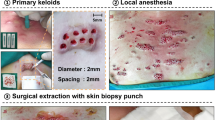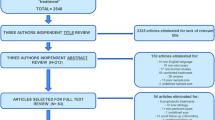Abstract
Intralesional corticosteroid injection is a well-recognised treatment modality for keloid disease (KD). Approximately 50 % of KD cases are considered non-responders (or steroid resistant) with no consensus or indicators in detecting steroid-sensitive cases. In view of the undesirable side effects, uncertainty in timing and regularity of steroid treatment, we planned to identify responders and non-responders to target treatment more effectively. A scar injection proforma was developed capturing a detailed history focusing on symptoms and signs (redness, appearance, contour, texture, distortion and severity) associated with KD. The cause, site, number of keloid scars and scar recurrence were recorded as the lesions were injected on a monthly basis. A detailed description of response to steroid injection was documented and photographs were taken. Demographic data were collected on 65 patients (11 to 74 years with mean age 34.7 years, 60 % were females, 50 % were Caucasian). 77 % (n = 50) were classified as steroid responders and showed improvement in symptoms and signs within 3 months. There was a statistically significant correlation between patients with higher contour scores of KD prior to treatment (p = 0.013) and frequency of injections (p = 0.003). Thus, the odds of being a responder were greater for patients with more than one injection and with higher contour scores. This preliminary case series has provided early evidence in enabling identification of steroid responders versus non-responders within a 3-month period. Selection of KD non-responders to steroid treatment can avoid potentially painful injection, its subsequent side effects and unnecessary continuation of redundant therapy and follow-up.





Similar content being viewed by others
References
Ardehali B, Nouraei SA, Van Dam H, Dex E, Wood S, Nduka C (2007) Objective assessment of keloid scars with three-dimensional imaging: quantifying response to intralesional steroid therapy. Plast Reconstr Surg 119:556–561
Asilian A, Darougheh A, Shariati F (2006) New combination of triamcinolone, 5-fluorouracil, and pulsed-dye laser for treatment of keloid and hypertrophic scars. Dermatol Surg 32:907–915
Atiyeh BS (2007) Nonsurgical management of hypertrophic scars: evidence-based therapies, standard practices and emerging methods. Aesthet Plast Surg 31:468–492
Bayat A, McGrouther D, Ferguson M (2003) Skin scarring. BMJ 326:88–92
Beausang E, Floyd H, Dunn KW, Orton CI, Ferguson MW (1998) A new quantitative scale for clinical scar assessment. Plast Reconstr Surg 102:1954–1961
Beranak JT (1997) Silicone gel sheeting for the management of hypertrophic and keloids scars: the mechanism of its action. Dermatol Surg 23:401–405
Berman B, Flores F (1999) Comparison of a silicone gel-filled cushion and silicone gel sheeting for the treatment of hypertrophic or keloid scars. Dermatol Surg 25:484–486
Boutli-Kasapidou F, Tsakiri A, Anagnostou E, Mourellou O (2005) Hypertrophic and keloidal scars: an approach to polytherapy. Int J Dermatol 44:324–327
Boyadjiev C, Popchristova E, Mazgalova J (1995) Histomorphologic changes in keloids treated with Kenacort. J Trauma 38:299–302
Brent B (1978) The role of pressure therapy in management of earlobe keloids: preliminary report of a controlled study. Ann Plast Sur 1:579–581
Brown BC, McKenna SP, Siddhi K, McGrouther DA, Bayat A (2008) The hidden cost of skin scars: quality of life after skin scarring. J Plast Reconstr Aesthet Surg 61:1049–1058
Brown BC, McKenna SP, Solomon M, Wilburn J, McGrouther DA, Bayat A (2010) The patient-reported impact of scars measure: development and validation. Plast Reconstr Surg 125:1439–1449
Brown BC, Moss TP, McGrouther DA, Bayat A (2010) Skin scar preconceptions must be challenged: importance of self-perception in skin scarring. J Plast Reconstr Aesthet Surg 63:1022–1029
Conejo-Mir JS, Corbi R, Linares R (1998) Carbon dioxide laser ablation associated with interferon alfa-2b injection reduces the recurrence of keloids. J Am Acad Dermatol 39:1039–1040
Converse JM, Stallings JO (1972) Eradication of large auricular keloids by excision, skin grafting, and intradermal injection of triamcinolone acetonide solution. Case report. Plast Reconstr Surg 49:461–463
Cruz NI, Korchin L (1994) Inhibition of human keloid fibroblast growth by isotretinoin and triamcinolone acetonide in vitro. Ann Plast Surg 33:401–405
Darougheh A, Asilian A, Shariati F (2007) Intralesional triamcinolone alone or in combination with 5-fluorouracil for the treatment of keloid and hypertrophic scars. Clin Exp Dermatol 34:219–223
Darzi MA, Chowdri NA, Kaul SK, Khan M (1992) Evaluation of various methods of treating keloids and hypertrophics scars: a 10-year follow-up study. Br J Plast Surg 45:374–379
Donkor P (2007) Head and neck keloid: treatment by core excision and delayed intralesional injection of steroid. J Oral Maxillofac Surg 65:1292–1296
Fitzpatrick RE (1999) Treatment of inflamed hypertrophic scars using intralesional 5FU. Dermatol Surg 25:224–232
Gangemi EN, Gregori D, Berchialla P et al (2008) Epidemiology and risk factors for pathologic scarring after burn wounds. Arch Facial Plast Surg 10:93–102
Hollywood KA, Maatje M, Shadi IT, Henderson A, McGrouther DA (2010) Phenotypic profiling of keloid scars using FT-IR microspectroscopy reveals a unique spectral signature. Arch Dermatol Res 302:705–715
Iqbal SA, Sidgwick GP, Bayat A (2012) Identification of fibrocytes from mesenchymal stem cells in keloid tissue: a potential source of abnormal fibroblasts in keloid scarring. Arch Dermatol Res 304:665–671
Jalali M, Bayat (2007) Current use of steroids in management of abnormal raised skin scars. Surgeon 5:175–180
Kill J (1977) Keloids treated with topical injections of triamcinolone acetonide (kenalog): immediate and long-term results. Scand J Plast Reconstr Surg 11:169–172
Koc E, Arca E, Surucu B, Kurumlu Z (2008) An open, randomized, controlled, comparative study of the combined effect of intralesional triamcinolone acetonide and onion extract gel and intralesional triamcinolone acetonide alone in the treatment of hypertrophic scars and keloids. Dermatol Surg 34:1507–1514
Krusche T, Worret WI (1995) Mechanical properties of keloids in vivo during treatment with intralesional triamcinolone acetonide. Arch Dermatol Res 287:289–293
Larrabee WF, East CA, Jaffe HS, Stephensen C, Peterson KE (1990) Intralesional interferon gamma treatment for keloids and hypertrophic scars. Arch Otolaryngol Head Neck Surg 116:1159–1162
Layton AM, Yip J, Cunliffe WJ (1994) A comparison of intralesional triamcinolone and cryosurgery in the treatment of acne keloids. Br J Dermatol 130:498–501
Lee Y, Minn KW, Baek RM, Hong JJ (2001) A new surgical treatment of keloid: keloid core excision. Ann Plast Surg 46:135–140
Leventhal D, Furr M, Reiter D (2006) Treatment of keloids and hypertrophic scars. Arch Facial Plast Surg 8:362–368
Low SQ, Moy RL (1992) Scar war strategies. Target collagen. J Dermatol Surg Oncol 18:981–986
Manuskiatti W, Fitzpatrick RE (2002) Treatment response of keloidal and hypertrophic sternotomy scars. Comparison among intralesional corticosteroid, 5-fluorouracil, and 585 nm flashlamp-pumped pulsed dye laser treatments. Arch Dermatol 138:1149–1155
McCoy BJ, Diegelmann RF, Cohen IK (1980) In vitro inhibition of cell growth, collagen synthesis, and prolyl hydroxylase activity by triamcinolone acetonide. Proc Soc Exp Biol Med 163:216–222
Mustoe TA, Cooter RD, Gold MH et al (2002) International clinical recommendations on scar management. Plast Reconstr Surg 110:560–571
Nedelec B, Shankowsky H, Tredget E (2000) Rating the resolving hypertrophic scar: comparison of the Vancouver Scar Scale and scar volume. J Burn Care Rehabil 21:205
Ragoowansi R, Cornes PGS, Glees JP, Powell BW, Moss AL (2001) Ear-lobe keloids: treatment by a protocol of surgical excision and immediate postoperative adjuvant radiotherapy. Br J Plast Surg 54:504–508
Rahban S, Garner W (2003) Fibroproliferative scars. Clin Plast Surg 30:77–89
Reed BR, Clark RA (1985) Cutaneous tissue repair: practical implications of current knowledge, II. J Am Acad Dermatol 13:919–941
Robles D, Moore E, Draznin M, Berg D (2007) Keloids: patho-physiology and management. Dermatol Online J 13:9
Roques C, Teot L (2008) The use of corticosteroids to treat keloids: a review. Int J Low Extrem Wounds 7:137–145
Sadeghinia A, Sadeghinia S (2012) Comparison of the efficacy of intralesional triamcinolone acetonide and 5-fluorouracil tattooing for the treatment of keloids. Dermatol Surg 38:104–109
Salvarani C, Cantini F, Olivieri I, Barozzi L, Macchioni L, Boiardi L, Niccoli L, Padula A, Pulsatelli L, Meliconi R (2000) Corticosteroid injections in polymyalgia rheumatica: a double-blind, prospective, randomized, placebo controlled study. J Rheumatol 27:1470–1476
Seifert O, Mrowietz U (2009) Keloid scarring: bench and bedside. Arch Dermatol Res 301:259–272
Shih B, Bayat A (2010) Genetics of keloid scarring. Arch Dermatol Res 302:319–339
Shih B, Bayat A (2012) Comparative genomic hybridisation analysis of keloid tissue in Caucasians suggests possible involvement of HLA-DRB5 in disease pathogenesis. Arch Dermatol Res 304:241–249
Singer AJ, Clark RA (1999) Cutaneous wound healing. N Engl J Med 341:738–746
Sund B (2000) New developments in wound care. PJB Publications, London
Syed F, Bayat A (2013) Superior effect of combination vs. single steroid therapy in keloid disease: a comparative in vitro analysis of glucocorticoids. Wound Repair Regen 21:88–102
van Zuijlen P, Angeles A, Kreis R, Bos KE, Middlekoop E (2002) Scar assessment tools: implications for current research. Plast Reconstr Surg 109:1108
Wu WS, Wang FS, Yang KD, Huang CC, Kuo YR (2006) Dexamethasone induction of keloid regression through effective suppression of VEGF expression and keloid fibroblast proliferation. J Invest Dermatol 126:1264–1271
Yosipovitch G, Widijanti Sugeng M, Goon A, Chan YH, Goh CL (2001) A comparison of the combined effect of cryotherapy and corticosteroid injections versus corticosteroids and cryotherapy alone on keloids: a controlled study. J Dermatol Treat 12:87–90
Author information
Authors and Affiliations
Corresponding author
Rights and permissions
About this article
Cite this article
Ud-Din, S., Bowring, A., Derbyshire, B. et al. Identification of steroid sensitive responders versus non-responders in the treatment of keloid disease. Arch Dermatol Res 305, 423–432 (2013). https://doi.org/10.1007/s00403-013-1328-7
Received:
Revised:
Accepted:
Published:
Issue Date:
DOI: https://doi.org/10.1007/s00403-013-1328-7




